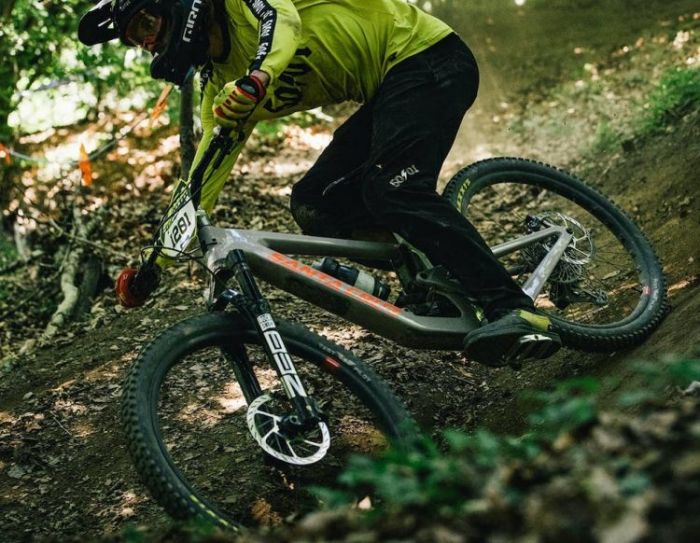Trek 520
- Price: $1829
- Frame: Steel
- Wheels: 700c
- Drivetrain: 3 × 9
- Groupset: Alivio, Sora
- Brakes: Mechanical Disc
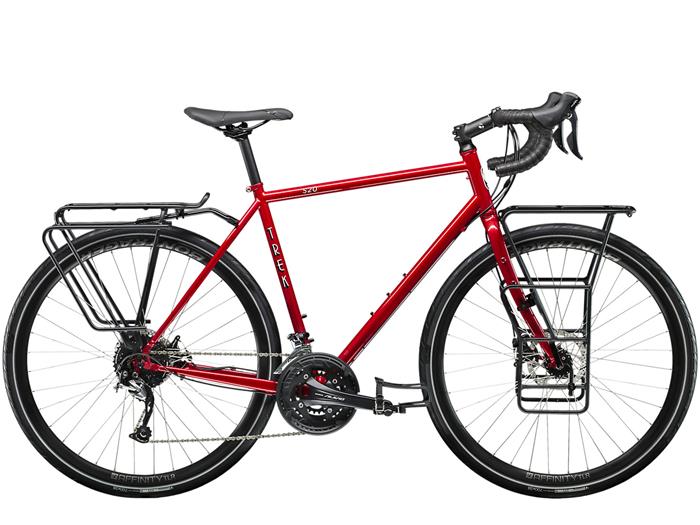
What we like about it: Trek’s 520 is a high-performance, comfortable, versatile bike that balances performance, comfort, and versatility effectively. My Trek 520 accompanied me on numerous statewide touring expeditions and came home fully loaded.
What we do not like about it: Disc brakes would be a much better choice for the Trek 520 in wet weather and on long, steep descents.
Trek is continuing the legendary style with the release of the Trek 520. According to Trek, the Trek 520 is a long-distance touring bike.
The company has centered its research and development around that selling point and has continued to develop it for the masses.
Overall comfort, Trek 520 is not easy to cause fatigue, especially in the shoulders and neck, lumbar spine, prostate, and other key areas.
As a Trek 520, you’ll receive substantial, durable, easy-to-maintain, universally compatible parts that will serve your needs without too much servicing, and without having to spend a lot of money on tuned the bike or replacement parts.
When it breaks, it can be repaired easily or replaced easily (especially in remote locations).
Under high load conditions, the Trek 520 handles smoothly. All-road adaptability is primarily reflected in the frame’s high strength, the wide selection of gear ratios, strong traction, easy glide tires, and certain vibration dampening properties.
I’m sure you’re eager to learn more about the Trek 520 after reading all these compliments, so let’s follow our testers and find out more.
Learn more: How A Bike With Ambitions Did It – Trek 720 Review
Main features
Frame (4.5/5)
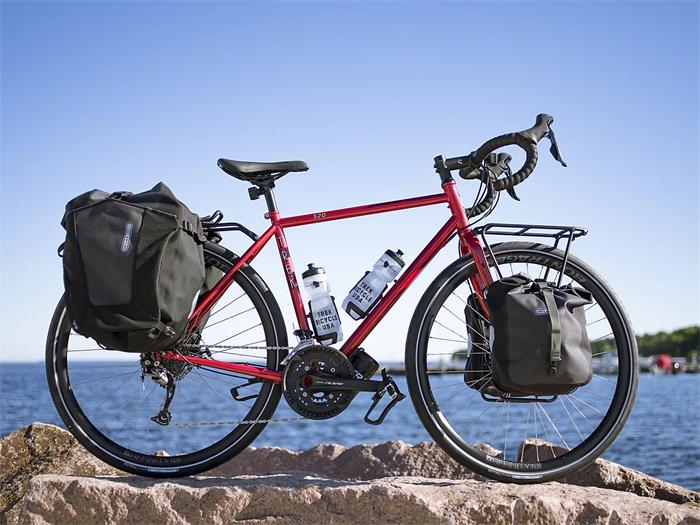
A lot of people aren’t aware of why the Trek 520’s frame is made of Chromoly steel. The reason for this is that a true fully loaded touring bike is very different from a normal bike (no-load capacity).
Your Trek 520 bike frame is more likely to deform if you put too much weight on it. This leads to some unsettling factors such as more wobbly and unstable riding. And sometimes it can be dangerous.
Therefore, a Trek 520 touring bike frame needs to be stronger and sturdier than normal to cope with the pressure when carrying a load.
It’s because of this reason that the Trek 520 uses super hard Chromoly steel as the frame material.
So, the core of the Trek 520 is the Trek butted Chromoly disc touring, and our testers suggested that the other parts could be replaced, but not the frame.
You might get the impression that the Trek 520 looks a bit rough under no weight, but once it’s underweight, the Trek 520 looks very well-coordinated, especially on climbs. This is where the strong frame comes into play.
Geometry (4.4/5)
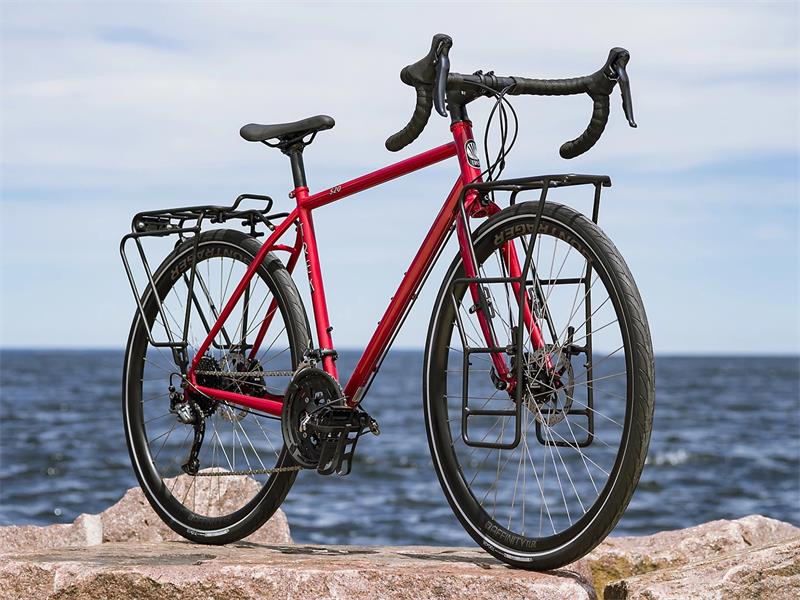
Frame geometry is a very complex subject. As someone who has reviewed so many bikes, I’m sure you understand that there is a huge difference between “Comfort” and “Aggressive” frames.
The former frame geometry is designed for a comfortable, relaxed ride, i.e. designed for touring.
“Aggressive” geometry has been designed for racing, and it offers greater acceleration and agility, but not much comfort.
Trek has spent many years refining the 520 geometry for heavy duty and long distance touring needs.
In the Trek 520’s frame geometry, the head tube has been made taller for a more upright riding position.
The lowered height of the bottom bracket and longer wheelbase provide better stability.
Thus, the design logic of the Trek 520 can also be seen in its geometry changes.
Components and Specifications
Drivetrain (4.7/5)
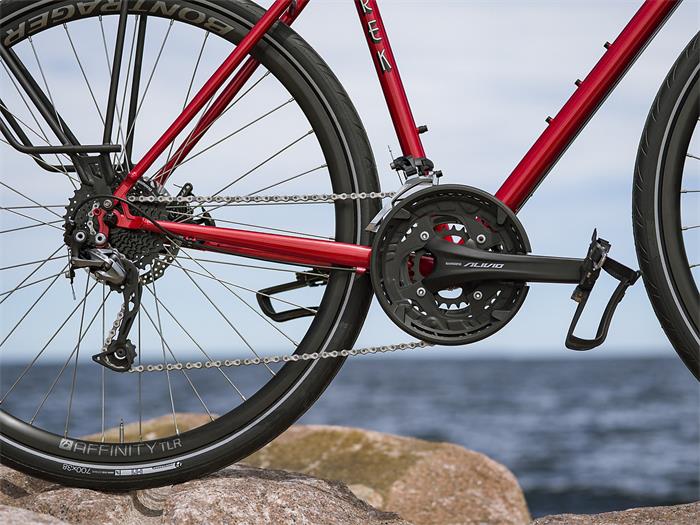
Shifter
The Trek 520 pointer uses Shimano Sora R3000, 9 speed, and R3030, 3 speed.
Shimano Sora is targeted at entry-level riders & high-level sports fitness and is the highest level of Shimano road kit.
The Shimano Sora R3000 and R3030 have STI dual control, meaning they can be used for 9 and 3-speed shifting and braking.
They also come with internal cable routing, making the Trek 520 driver’s seat neat and tidy.
With Shimano’s Optislick cable, the cable runs through the seat tube and connects to the handlebar-mounted lever, ensuring superior performance in dusty and muddy conditions.
The improved Super SLR technology ensures an optimal transition from joystick travel to braking power. SLR refers to Shimano’s linear response.
In Shimano Sora R3000 and R3030, this braking system is designed for maximum friction reduction in the brake caliper, brake lever, and inner cable. This improves the brake’s responsiveness and dosage.
Front and rear derailleurs
In our tester’s tests, the Trek 520 was found to be equipped with a Shimano Alivio M4000 rear derailleur and a Shimano Sora R3030 front derailleur.
In Shimano’s Sora R3030 front derailleur, wide pivot links increase rigidity while decreasing flex, improving shift response, and ensuring relatively precise shifting.
Aluminum links and straps reduce weight and increase rigidity.
Shimano Sora R3030 wraps around the Trek 520 seat tube. The item comes with two extra shims for seat tubes with smaller diameters, as well as a clamp on down pull.
The Shimano Alivio M4000 rear derailleur provides crisp on- and off-road performance for a 9-speed drivetrain.
The concealed rear derailleur design with a smooth skid plate surface has an ultra-low profile design that reduces the risk of encountering a mountain side endangering the Shimano Alivio M4000 with damage.
A wide link design increases rigidity and longevity.
The alloy body and external links result in lower weight without sacrificing strength and durability.
Shimano Alivio M4000 has 11-tooth pulleys to reduce pulley wear and chain noise.
Crank
Our recommendation is that if you intend to buy a real mountain bike that will allow you to start enjoying trails, the kit should at least include the Alivio.
Specifically, the Alivio is the first level of Shimano mountain bike kits to include a two-piece crank system (two-piece crankset) with a separate center shaft for increased crank strength.
The Trek 520 crankset uses Shimano Alivio T4060 at an affordable price.
Shimano Alivio T4060 crank rigidity, durability, and lubrication, the testers feel good after testing.
HYPERGLIDE sprockets are designed with specially positioned shift ramps and tooth profiles for better chain control during shifting.
In this way, indexed shifting becomes fast and responsive.
Shimano Alivio T4060 is a two-piece crank system. With an integrated crank arm and bottom bracket, rigidity is increased while weight is reduced.
A wider bearing position enhances rigidity and efficiently transmits pedaling force.
Cassette
Its cassette range is 11-36T, and the gear cassettes are positioned precisely relative to each other so that the chain moves smoothly.
Trek 520 has a Shimano HG200 9-speed cassette, a gear ratio combination that provides smooth and comfortable pedaling.
Our testers found the Shimano HG200 flywheel’s clever angled chamfer and fast, smooth shifting to be the biggest advantages of the Trek 520. Even under high pedaling loads, smoother shifts are possible, both up and down.
Riders can put all their power into pedaling and achieve faster shifting for smoother and better speed translation.
Fork (4.5/5)
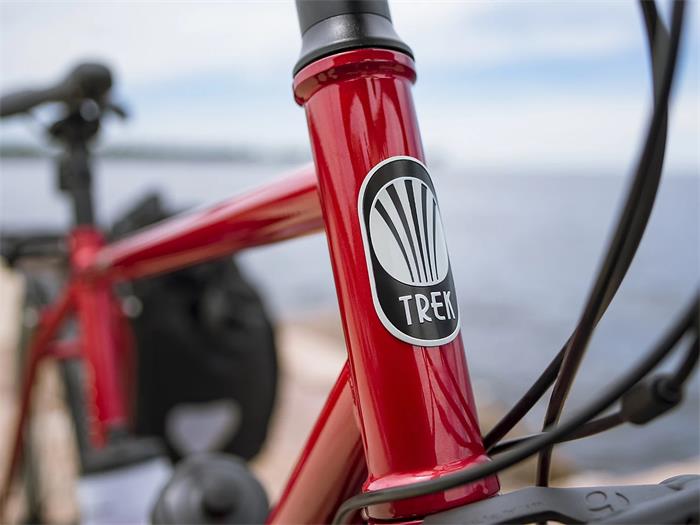
The corrosion resistance of aluminum alloy makes its own longevity and durable strength more convincing compared to other forks, more robust, durable, and smooth, making the whole ride full of excitement.
Trek 520 fork is using Alloy disc touring.
In order to improve comfort and reliability, Trek has improved and upgraded the frame + fork.
The main body of the frame is as described above, but the fork material has been changed from steel to aluminum, and the weight has been reduced as a result.
The frame is also equipped with Trek’s newly developed ThruSkew quick release technology.
Trek claims this technology is the result of the combination of a barrel axle and quick release, which allows riders to take off the front wheel without removing the front rack.
Another point that our testers happened to mention, I feel the need to say. You can make a reference.
Congratulations, if you bought a Trek 520 fork that hasn’t been cut yet. You can fit the handlebars to your needs instead of adapting to them.
You can find the height you feel most comfortable with (and cut it to your own requirements if necessary).
However, if the Trek 520 has been cut by the dealer before you get it, then it may not reach the height you want to adjust (in this case, the dealer cut the steering tube too short).
Although this is not very important, it should at least be a factor to consider.
Headset (4.4/5)
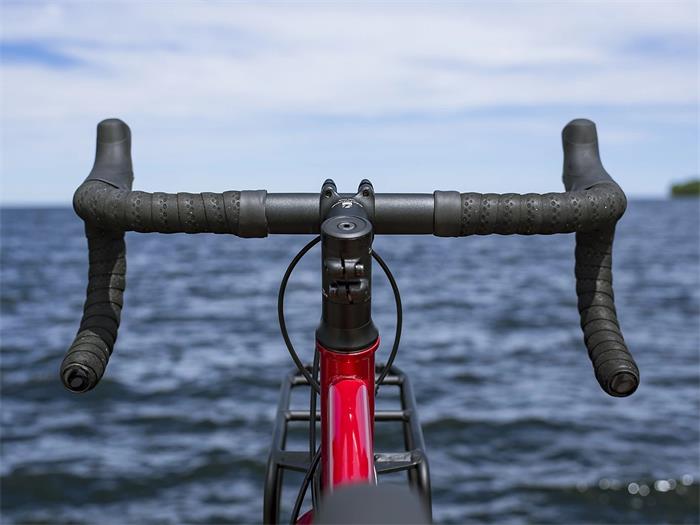
The headset is a bearing assembly located at the head tube that connects the handlebars to the top tube of the fork and is used to steer and control balance.
Threadless designs are now more common, and the Trek 520 uses a 1-1/8” threadless design with sealed bearings.
This threadless design is simpler and arguably superior. It is faster and easier to repair and can be done with standard tools.
Wheels (4.3/5)
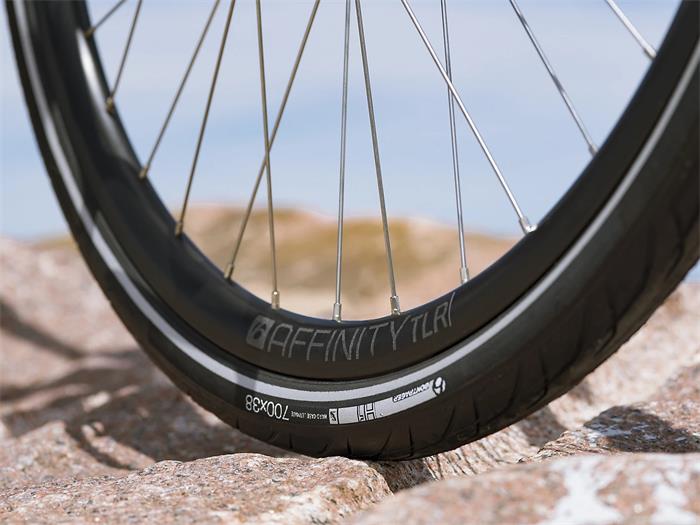
The Trek 520 rims feature the Bontrager Affinity Disc, which can be paired with vacuum tires.
The Trek 520 can ride heavily loaded thanks to the Bontrager Affinity Disc’s highly robust 36-hole rim and 14g premium carbon steel spokes.
Notably, the rim is 21mm wide and features a presta valve.
The Presta valve is currently used mainly on the more mid-to-high-end models.
Manual locking valve, high-pressure resistance, smoother air leakage linearity, a thin base of the valve, light weight, air closure is also very good, the diameter of the valve is small, so the rim’s valve hole opening can be smaller, the natural impact on the strength of the rim is less.
In the eyes of our testers, the rim is important, and the Trek 520 is better off with a double-layer rim.
The Trek 520 front and rear hubs are Shimano M475.
The hubs are the core of the wheelset, and when you decide to build a wheelset, basically everyone starts with the hubs to choose.
Shimano’s hubs are well made, reliable, and smoothly rotating, and the Shimano M475 is strong and refuses to break an axle. 100mm in length for the Trek 520 front hub and 135mm for the rear hub.
The Trek 520 uses the Bontrager H1, 700x38c tire with a super strong nylon casing, 700mm outside diameter, and 38mm width.
The tire’s engineered tread design provides confidence in wet or dry conditions. the Bontrager H1 tread uses a durable compound for longer life.
Trek 520 Spece
Frameset
| Bike | Trek 520 | Trek 520 Grando |
| Frame | Trek butted Chromoly disc touring, rack & fender mounts, 135x5mm QR | Trek butted Chromoly disc touring, rack & fender mounts, 135x5mm QR |
|---|---|---|
| Fork | Alloy disc touring, rack mounts, 100x5mm ThruSkew | Alloy disc touring, rack mounts, 100x5mm ThruSkew |
| Fender/rack mounts | Bontrager BackRack Deluxe, Interchange compatible, size small | N/A |
Wheels
| Hub front | Shimano M475, 6-bolt disc, 100x5mm QR |
|---|---|
| Hub rear | Shimano M475, 6-bolt disc, 135x5mm QR |
| Rim | Bontrager Affinity Disc, Tubeless Ready, 36-hole, 21mm width, Presta valve |
| Spokes | 14g stainless steel |
| Tire | Bontrager H1 Hard-case Ultimate, 700x38c w/reflective sidewall |
| Max tire size | 29×2.00″ without fenders |
Drivetrain
| *Shifter | Size: 48, 51, 54, 57, 60, 63 Shimano Sora R3000, 9 speed Size: 48, 51, 54, 57, 60, 63 Shimano Sora R3030, 3 speed | Shimano Tiagra R4700, 10 speed |
|---|---|---|
| Front derailleur | Shimano Sora R3030, 34.9mm (w/28.6 adapter) clamp | Shimano Tiagra 4700, 34.9mm clamp, down swing |
| Rear derailleur | Shimano Alivio M4000, long cage, 36T max cog | Shimano GRX RX400, long cage, 36T max cog |
| *Crank | Size: 48, 51 Shimano Alivio T4060, 48/36/26, 2-piece w/chain guard, 170mm length Size: 54, 57, 60, 63 Shimano Alivio T4060, 48/36/26, 2-piece w/chain guard, 175mm length | Size: 48, 51 ProWheel forged alloy, 42/28, 2-piece, 170mm length Size: 54, 57, 60, 63 ProWheel forged alloy, 42/28, 2-piece, 175mm length |
| Cassette | Shimano HG200, 11-36, 9 speed | Shimano HG50, 11-36, 10 speed |
| Chain | KMC X9 | KMC X10, 10 speed |
| Pedal | Wellgo nylon body, alloy cage | Wellgo nylon body, alloy cage |
| Max chainring size | 48T w/3x, 42T w/2x | 48T w/3x, 42T w/2x |
Components
| Saddle | Bontrager Evoke |
|---|---|
| *Seatpost | Size: 48 Bontrager alloy, 27.2mm, 12mm offset, 250mm length Size: 51, 54, 57, 60, 63 Bontrager alloy, 27.2mm, 12mm offset, 330mm length |
| *Handlebar | Size: 48 Bontrager Comp VR-C, alloy, 31.8mm, 100mm reach, 124mm drop, 40cm width Size: 51, 54 Bontrager Comp VR-C, alloy, 31.8mm, 100mm reach, 124mm drop, 42cm width Size: 57, 60, 63 Bontrager Comp VR-C, alloy, 31.8mm, 100mm reach, 124mm drop, 44cm width |
| Handlebar tape | Bontrager Gel Cork tape |
| *Stem | Size: 48 Bontrager Elite, 31.8mm, Blendr compatible, 7 degree, 80mm length Size: 51 Bontrager Elite, 31.8mm, Blendr compatible, 7 degree, 90mm length Size: 54, 57 Bontrager Elite, 31.8mm clamp, Blendr compatible, 7 degree, 100mm length Size: 60, 63 Bontrager Elite, 31.8mm clamp, Blendr compatible, 7 degree, 110mm length |
| Headset | 1-1/8” threadless, sealed cartridge bearings |
| Brake | TRP Spyre C 2.0 mechanical disc, 160mm rotor |
Accessories
| *Cargo rack | Size: 48, 51, 54 Bontrager BackRack Deluxe, Interchange compatible, size small Size: 48, 51, 54, 57, 60, 63 Bontrager Carry Forward Size: 57, 60, 63 Bontrager BackRack Deluxe, Interchange compatible, size large | Bontrager Carry Forward |
|---|
Weight
| Weight | 54 – 14.24 kg / 31.4 lbs | 54 – 13.28 kg / 29.27 lbs |
|---|---|---|
| Weight limit | This bike has a maximum total weight limit (combined weight of bicycle, rider, and cargo) of 275 pounds (125 kg). | This bike has a maximum total weight limit (combined weight of bicycle, rider, and cargo) of 275 pounds (125 kg). |
FAQs
1. How much weight can the rack support?
15kg each
2. When mounting the kickstand, what bolt size is used?
Size M5
3. This frame uses what type of rear brake mount?
The 520 has an IS mount brake.
Comparison table
| BIKE | PRICE | CATEGORY | GROUPSET | DRIVETRAIN | OFFERS |
| Trek 520 Grando | $1,829 | Gravel | 700c | 2 × 10 | CLICK VIEW |
| Salsa Marrakesh Alivio | $1,999 | Gravel | 700c | 3 × 9 | CLICK VIEW |
| Trek 920 | $2,099 | Touring | 700c | 2 × 10 | CLICK VIEW |
| Fuji Touring Disc | $1,499 | Touring | 700c | 3 × 10 | CLICK VIEW |
Compare
Trek 520 Grando vs Trek 520

Next, comes our comparison of the Trek 520 and Trek 520 Grando, and after reading it you will know which is the better final verdict.
So which is better? Well, the main difference between the Trek 520 and the Trek 520 Grando is their shifters.
For its rear derailleur, Trek 250 uses the Shimano Alivio, while its front derailleur uses the Shimano Sora. In contrast, the Trek 520 Grando uses a Shimano Tiagra front derailleur and Shimano GRX rear derailleur.
The rear derailleur, which is Shimano GRX RX400, will help you achieve better chain tension and smooth, highly reliable shifting, especially on rough terrain.
As part of the Trek 520 Grando, you will also get two-piece ProWheel alloy cranks.
However, both bikes use the 1136 cassette, even though the Trek 520 Grando is faster.
The Trek 520 has a more range than the Trek 520 Grando since it has three chain links instead of the Trek 520 Grando’s two chain links.
Rear Rack
Unlike the 520 Grando, the Trek 520 has a backpack rack. The Trek 520 is equipped with a Bontrager backpack rack at the front and rear ends that can hold about 55 pounds or 25 kilograms.
Sleeping bags, food, tents, and other essentials can be stowed on the front and rear racks.
During your travels, the racks are made of durable materials that can support the weight of your gear.
However, the Trek 520 Grando only has a front rack, which means you won’t have enough room to store any luggage if you’re taking a road trip through the woods.
Tires
Both bikes are fitted with different tires, but the Trek 520 Grando has more versatile tires.
Bontrager H1 Hard-case Ultimate tires are fitted to the Trek 520, and they are 700×38c wide.
Nevertheless, the Trek Grando comes with 700×40c tires that are made by Bontrager.
There’s no way to compare the two tires to know which is better since they’re different. The Trek 520 tire, however, has a thinner casing, but it has a harder casing, so rocks, thorns, and other road debris are less likely to penetrate the tire.
Its wide and nimble tires provide more traction on dirt roads and gravel roads, making the Trek 520 Grando a more versatile bike.
Regarding the Trek 520 Grando tires. They’re wide and nimble, so they offer better traction on dirt and gravel roads, which makes the Trek 520 Grando a more versatile bicycle.
However, you can equip both bikes with 29.2-inch wheels to improve their traction and adaptability.
With the wide fat rolling tires, you will have enough traction on both pavement and gravel roads, so you can ride with confidence.
Weight
In comparison to the Trek 520, the Trek 520 Grando is lighter. Including the weight of the rider and bike cargo, the maximum total weight capacity of each bike is 275 pounds.
Although it might not seem significant, the Trek 520 Grando weighs 2 pounds less than the Trek 520.
In analyzing the differences between the two bikes, you should take this into account.
Salsa Marrakesh Alivio vs Trek 520

Unlike the Trek 520, the Salsa Marrakesh Alivio frame and fork are made of triple-butted Chromoly steel, which remains strong and durable even under wear and tear.
The Shimano Deore 3×9 drivetrain shifts with precision, and the 26x34t (21 gear inches) low-speed gears allow fully loaded travelers to climb rugged trails on the Salsa Marrakesh Alivio.
The 36-hole WTB ST i19 rims remained true to form after our testers struggled to ride 400km under heavy loads.
When it comes to Gear Range, these two bikes are almost identical! So what else is the difference?
The Salsa Marrakesh Alivio comes with Shimano M475 QR 36h, WTB ST i19 TCS 2.0 rims, and Teravail Rampart 700c x 42mm durable, tubeless tires.
The Salsa Marrakesh Alivio is equipped with a WTB Volt Sport saddle, while the Trek 520 uses a Bontrager Evoke saddle.
The WTB Volt is our testers’ favorite mountain saddle, and the WTB Volt Sport is shaped with speed and comfort in mind. The medium-thickness padding and wonderful curves make the WTB Volt Sport saddle the most popular of the WTBs as well.
Looking at the shape, the WTB Volt Sport’s upward curved tail and slightly sloping nose make for propulsion during pedaling.
Trek 920 vs Trek 520
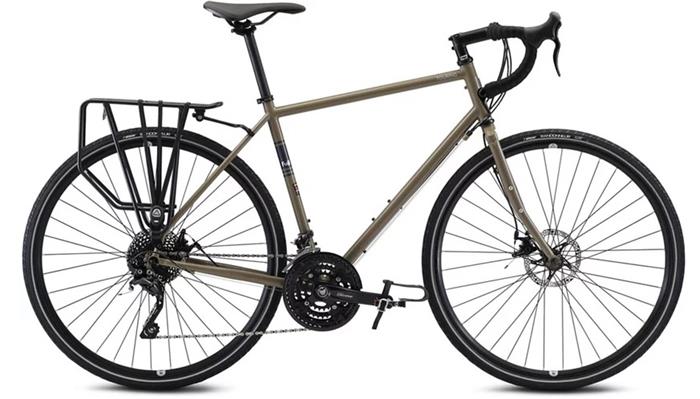
When it comes to price you’ll find that the Trek 520 costs $1829, which is $270 less than the Trek 920.
Trek’s 920 is positioned as an adventure touring bike in its own right, featuring an all-aluminum frame and fork construction that weighs just 28.4 lbs/12.9 kg.
With the Trek 920, you get hydraulic disc brakes, 29′′ wheels with Bontrager XR1 tires, and 29 x 2.00′′ tires.
The Trek 920 comes with a Bontrager Duster Elite, Tubeless Ready, 100x15mm thru-axle rim, while the Trek 520 has a Bontrager Affinity Disc, Tubeless Ready, 36-hole, 21mm width rim.
The Trek 520 has clearance for up to accommodate 29 x 2.0” 700c x 50 mm tires. And the Trek 920 can also fit, 2.3″ fenderless or 2″ with fenders.
Some of the Trek 920’s dimensions match the Trek 520’s classic touring geometry, with the same 1.49 stack/stretch ratio, making it a fairly upright riding position.
Trail refers to the horizontal distance of the front tire’s point of contact with the ground from the steering axis. A high trail value provides more stability at speed and a tendency to self-correct, which is good for rough terrain where it is important to maintain a line over roots and rocky roads.
The Trek 920 trails fairly similarly to the Trek 520 with only a 3mm difference. The Trek 920 has 68mm which makes it more stable, but it is still not sluggish.
Learn more :Is Trek 1120 A Good Bike? [Trek 1120 Review]
Fuji Touring Disc vs Trek 520

The Fuji Touring model dates back to the 1990s and in 2018 it achieves a twenty-first century breakthrough.
This Fuji Touring Disc update comes with some nice spec Shimano Deore 10-speed cassette 11-46T to your Deore triple crank.
Microshift bar-end shifters and TRP break levers, Oval Concepts brands supplies handlebar, 3D-forged 6061stem, Selle Royal Vivo saddle, and 6061 alloy seat post.
Riders can easily handle both flats and hills thanks to the Shimano drivetrain’s ultra-wide 3×10 gearing ranges. Featuring a heavy-duty rear rack, dual eyelets for mounting additional racks, and low-rider mounting points for securing front panniers.
The Fuji Touring Disc frame is made of double-butted, heat-treated Reynolds 520 Chromoly steel, the Trek 520 uses Trek butted Chromoly disc touring.
They offer equal durability and similar mechanical properties. However, the Fuji Touring Disc frame offers a degree of flexibility that suppresses more pit vibrations during the ride.
Fuji Touring Disc is Shimano Deore for the entire drivetrain except for the KMC chain. it is a great value, reliable and durable. The rear shifter is indexed and the front shifter is friction.
Our testers did a lot of fine-tuning, and the shifting wasn’t as crisp and clean as the Trek 520 Shimano Sora shifting, but it was also 100% reliable in testing.
Comprehensive evaluation (4.6/5)
The Trek 520 is a great gravel bike with a medium price among the 4 bikes compared and good quality overall frame and components. The Trek 520 is the perfect choice when you are adventuring on your own or with family and friends. He can help you carry heavy loads, is stable and solid. Of course, we accidentally found many of our buddies also use it for commuting to and from work, which is also a comfortable experience. You’ll be happy with it!
Learn more:Top 8 Best Gravel Bikes Under $2000

![[Orbea URRUN 10 20mph Review] – Best Used By People Who Enjoy Riding To Get AFeel For The Mountains!](https://bestbikeselect.com/wp-content/uploads/2023/09/2023-Orbea-URRUN-10-20mph-35_-1024x1024.jpg)
![[Specialized Turbo Como 5.0 Review] – Good Choice?](https://bestbikeselect.com/wp-content/uploads/2023/08/2023-Specialized-Turbo-Como-5.01_-1024x1024.webp)
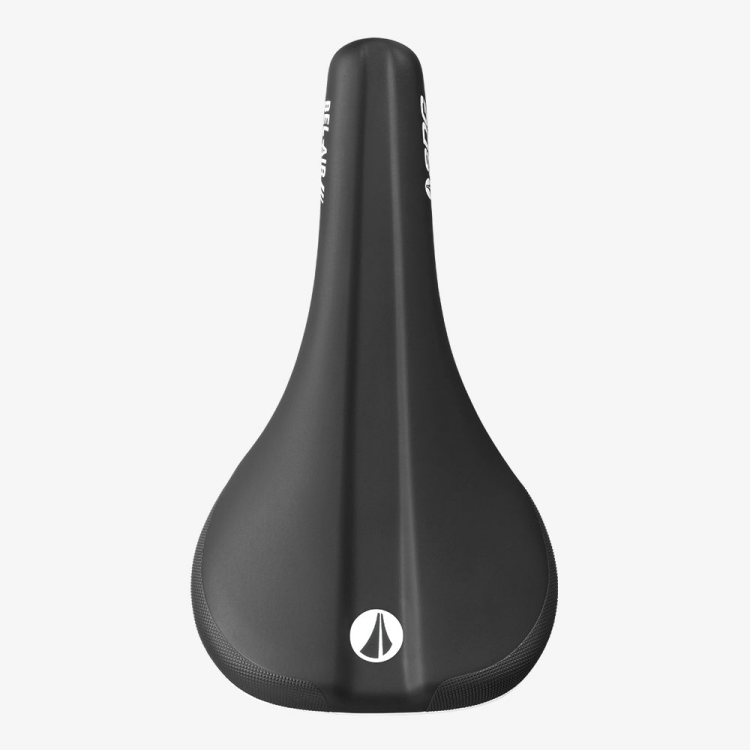
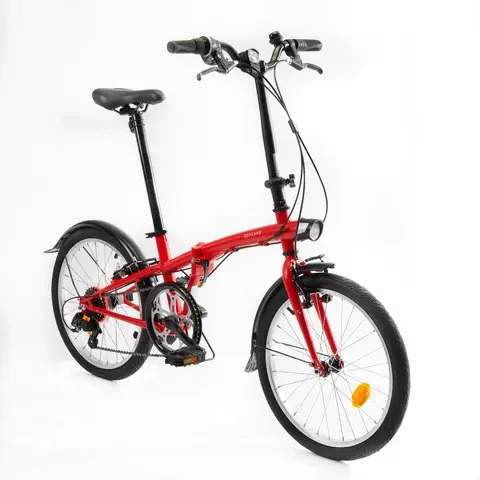
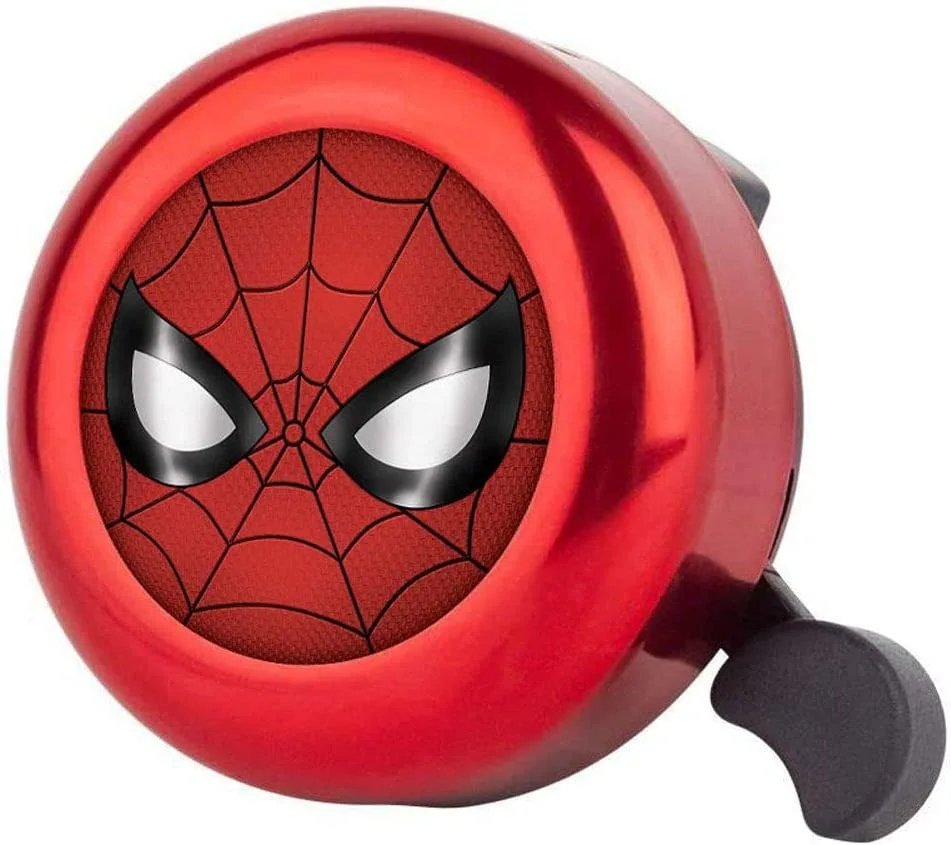
![2025 Built for Champions:[Orbea ORCA M21eTEAM PWR Review]](https://bestbikeselect.com/wp-content/uploads/2025/01/ORCA-M21eTEAM-PWR-1024x885.jpg)
![2025 Conquer Any Trail [Santa Cruz Bronson R Review]](https://bestbikeselect.com/wp-content/uploads/2025/01/Santa-Cruz-Bronson-R-1-1024x768.webp)
![2025 The All-Terrain Beast [Santa Cruz Hightower 3 MY24 Review]](https://bestbikeselect.com/wp-content/uploads/2025/01/Santa-Cruz-Hightower-3-MY24-1024x768.webp)
![The Best Comfortable Leisure Bike of 2025 [ Trek Verve 2 Lowstep Gen 5 ]](https://bestbikeselect.com/wp-content/uploads/2024/12/Verve-2-Lowstep-Gen-5-02-1024x681.png)
![2025’s Top Endurance Bikes [Cannondale Synapse Carbon 3 L Review]](https://bestbikeselect.com/wp-content/uploads/2025/01/Cannondale-Synapse-Carbon-3-L-1-1024x627.webp)
